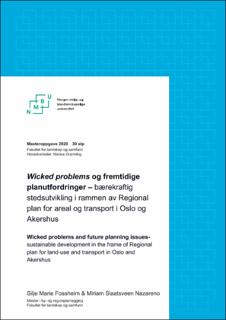| dc.contributor.advisor | Grønning, Marius | |
| dc.contributor.author | Fossheim, Silje Marie | |
| dc.contributor.author | Nazareno, Miriam Slaatsveen | |
| dc.coverage.spatial | Norway | en_US |
| dc.date.accessioned | 2020-09-25T14:36:47Z | |
| dc.date.available | 2020-09-25T14:36:47Z | |
| dc.date.issued | 2020 | |
| dc.identifier.uri | https://hdl.handle.net/11250/2679778 | |
| dc.description.abstract | Regional plan for areal og transport i Oslo og Akershus ble vedtatt i 2015, som et føringsdokument der kommuner og fylker må samarbeide om en regional omstilling, med et fokus på bærekraftig utvikling. Planen legger til rette for at areal- og transportutvikling skal sees over kommunegrensene, og baserer seg på nye prinsipper for by- og regionplanlegging. Prinsippene skal sikre matjord og naturressurser mot nedbygging, og konsentrere utbyggingen rundt miljøvennlig transportinfrastruktur - en historisk retningsendring i den regionale utviklingen, og et grep som har til hensikt å sikre en nødvendig og ønskelig politisk omstilling. Men hvilket ansvar sitter kommunene igjen med når et overordnet grep danner rammen for samordning? Hvordan ivaretar kommunene den politiske målsettingen om bærekraftig utvikling, når de skal planlegge den økonomiske, miljømessige og sosiale utviklingen av sine steder?
Denne studien ser nærmere på hvilke utfordringer neste generasjon av arealplaner vil stå overfor, i et langsiktig perspektiv. Dette i sammenheng med hvordan kommunale planmyndigheter i årene som kommer, skal følge opp regionale bærekraftsprinsipper og tilpasse prinsippene lokale forhold. Kjernen i en slik problematisering er en oversikt over historiske forutsetninger for fremveksten av urbane systemer og nettverk i Osloregionen, og en analyse av hvordan den regionale planen spiller videre på eller bryter med disse forutsetningene for stedenes videre utvikling. I den regionale planen blir enkelte områder prioriterte i henhold til bærekraftstematikken, mens andre blir liggende utenfor satsingsområdet planen fremmer for utvikling. En underliggende antakelse for studien er at det etterhvert vil dukke opp nye bærekraftsutfordringer når enkelte steder mister sine historiske forutsetninger for utvikling, mens andre får sine forsterket. Dette belyses ved å studere hvordan kommunale planer håndterer utviklingen av steder som befinner seg innenfor og utenfor satsingsområdene - et utvalg av steder som har hatt en historisk betydning i regionen.
På dette grunnlaget ender studien i en drøfting av mulige fremtidige utfordringer som kan prege arealplanleggingen i årene som kommer. Drøftingen baserer seg på forståelsen av bærekraftig utvikling, kompleksiteten i begrepet og hvordan fagfeltet i senere tid kanskje vil ha behov for en ny tilnærming til bærekraftstematikken. | en_US |
| dc.description.abstract | Regional plan for land-use and transport in Oslo and Akershus, was adopted in 2015, as a guiding document of where municipalities and counties must collaborate when restructuring the region, based on sustainable development. The plan facilitates that the development of land-use and transportation, must be seen across municipal boundaries, and the plan highlights new principles for urban and regional planning. The principles are intended to secure food soil and resources against demolition and is focused on concentrated development and environmental transportation. This is a historical change in regional development, and a measure aimed to ensure a necessary and desirable political restructuring. What responsibility does the municipalities have when an overall approach to planning forms the framework for coordination? How does the municipalities approach the political goals of sustainable development, in the aspects of economic, environmental and social development when planning on a local level?
This study looks closer at the challenges the next generation of land-use plans will face in the future. This study approach this in the context of how municipal planning authorities in the coming years, follow the regional sustainability principles and adapt the principles to local conditions. When studying such a problem, it is important to get an overview of historical preconditions for the growth of urban systems and networks in the Oslo region. It is also important to analyse how the regional plan are using these preconditions in the further development of the cities or if the plan undermines them. In the regional plan, some areas are prioritized according to a sustainable development, while others remain outside this focus area. An underlying assumption for the study is that it will eventually emerge new sustainability challenges when some places lose their historical preconditions for development, while others get their strengthened. This is illustrated by studying how municipal plans handle the development of places that are located inside and outside the focus area - a selection of places that had a historical significance in the region.
Based on this, the study ends in a discussion of possible future challenges that may characterize land-use planning in the years to come. The discussion is based on the understanding of sustainable development, the complexity of the concept and how the field of planning may need a new approach to sustainable issues in the future. | en_US |
| dc.language.iso | nob | en_US |
| dc.publisher | Norwegian University of Life Sciences, Ås | en_US |
| dc.rights | Navngivelse 4.0 Internasjonal | * |
| dc.rights.uri | http://creativecommons.org/licenses/by/4.0/deed.no | * |
| dc.subject | Bærekraftig utvikling | en_US |
| dc.title | Wicked problems og framtidige planutfordringer : bærekraftig stedsutvikling i rammen av Regional plan for areal og transport i Oslo og Akershus | en_US |
| dc.title.alternative | Wicked problems and future planning issues : sustainable development in the frame of Regional plan for land-use and transport in Oslo and Akershus | en_US |
| dc.type | Master thesis | en_US |
| dc.subject.nsi | VDP::Samfunnsvitenskap: 200 | en_US |
| dc.source.pagenumber | 111 | en_US |
| dc.description.localcode | M-BYREG | en_US |

